|
Lenoir County, North Carolina
Lenoir County is a county in the U.S. state of North Carolina. As of the 2020 census, its population was 55,122. Its county seat is Kinston, located on the Neuse River, across which the county has its territory. Lenoir County comprises the Kinston Micropolitan statistical area. History The county was formed in 1791 from the southern part of Dobbs County. It was named for William Lenoir (1751-1839), an officer in the American Revolutionary War who took part in the Battle of Kings Mountain. He was a prominent political leader; when the county was established, he was serving as Speaker of the North Carolina Senate. Geography According to the U.S. Census Bureau, the county has an area of , of which (0.6%) are covered by water. State and local protected site * CSS Neuse Major water bodies * Contentnea Creek * Neuse River * Southwest Creek * Wheat Swamp (Contentnea Creek tributary) Adjacent counties * Greene County - north * Pitt County - northeast * Craven County ... [...More Info...] [...Related Items...] OR: [Wikipedia] [Google] [Baidu] |
William Lenoir (general)
William Lenoir (May 8, 1751 – May 6, 1839) was an American Revolutionary War officer and prominent statesman in late 18th-century and early 19th-century North Carolina. Both the City of Lenoir, North Carolina and Lenoir County, North Carolina are named for him. Additionally, Lenoir City, Tennessee is jointly named for him and for his son, William Ballard Lenoir. The USS Lenoir (AKA-74) was also (indirectly) named for him. Family and early years The Lenoir name is of French origin, literally translating to "the black," which was a term that was similar to how the word "dark" is now used to speak of someone with dark hair and complexion. Lenoirs came to the English colonies in America from Brittany as a result of 17th century religious troubles. Brittany was just across the English Channel from Southern England. Because it had such a long coastline, it is no surprise how many mariners came from the area. The Lenoir coat-of-arms, "Le Noir de Nantes" is named for Nantes, ... [...More Info...] [...Related Items...] OR: [Wikipedia] [Google] [Baidu] |
Pitt County, North Carolina
Pitt County is a county located in the inner banks (northeastern part) of the U.S. state of North Carolina. As of the 2020 census, the population was 170,243, making it the fourteenth-most populous county in North Carolina. Its county seat is Greenville. Pitt County comprises the Greenville, NC Metropolitan Statistical Area. As one of the fastest-growing centers in the state, the county has seen a population boom since 1990. History The county was formed in 1760 from Beaufort County, though the legislative act that created it did not become effective until January 1, 1761. It was named for William Pitt the Elder, who was then Secretary of State for the Southern Department and Leader of the House of Commons. William Pitt was an English statesman and orator, born in London, England. He studied at Oxford University and in 1731 joined the army. Pitt led the young "Patriot" Whigs and in 1756 became secretary of state, where he was a pro-freedom speaker in British Colonial governm ... [...More Info...] [...Related Items...] OR: [Wikipedia] [Google] [Baidu] |
Kinston Regional Jetport
Kinston Regional Jetport , also known as Stallings Field, is a public airport located three miles (5 km) northwest of the central business district of Kinston, a city in Lenoir County, North Carolina. The airport has a single runway that is one of the longest in the southeastern United States. It is mostly used for general aviation. The Kinston Regional Jetport features free parking as well as free wireless Internet access in its terminal. The terminal also houses several businesses, including Philbros Gift and Coffee Shop as well as Robert Franchise Transportation, a commercial transportation service. Rental car agencies are located in the terminal. One of the central features of the Kinston Regional Jetport is the Global TransPark (GTP), an industrial park adjoining the airport. It was built to bring high-tech industry and economic development to eastern North Carolina. Spirit AeroSystems manufactures parts of the Airbus A350 at its Kinston facility at GTP. History Ki ... [...More Info...] [...Related Items...] OR: [Wikipedia] [Google] [Baidu] |
Amtrak Thruway
Amtrak Thruway is a system of through-ticketed transportation services to connect passengers with areas not served by Amtrak trains. In most cases these are dedicated motorcoach routes, but can also be non-dedicated intercity bus services, transit buses, vans, taxis, ferry boats and commuter rail trains. Train and Thruway tickets are typically purchased together from Amtrak for the length of a passenger's journey and connections are timed for guaranteed transfers between the two services. In addition to providing connecting service to unserved areas, some Thruway services operate as redundant service along passenger rail corridors to add extra capacity. History and purpose Amtrak operates the Thruway network to extend the reach of its train services, offering connections to destinations not directly served by Amtrak trains. The earliest incarnation of such a service was launched in January 1973, to provide a connection between Amtrak's Inter-American in Laredo, Texas, and t ... [...More Info...] [...Related Items...] OR: [Wikipedia] [Google] [Baidu] |
Selma, North Carolina
Selma is a town in Johnston County, North Carolina, United States. In 2010, the population was 6,073, and as of 2018 the estimated population was 6,913. Selma is part of the Raleigh-Durham-Cary Combined Statistical Area. The area has a population over 1.7 million residents, though the town of Selma is able to maintain its rural character. The Everitt P. Stevens House, located in Selma, was the site of the last Grand Review of the Confederate Army held on April 6, 1865, after its defeat at the Battle of Bentonville. Geography Selma is located in central Johnston County at (35.536982, -78.284642). It is bordered to the southwest by Smithfield, the county seat, and to the northwest by Wilson's Mills. According to the United States Census Bureau, the town of Selma has a total area of , all land. Demographics 2020 census As of the 2020 United States census, there were 6,317 people, 2,311 households, and 1,480 families residing in the town. 2000 census As of the census of 2 ... [...More Info...] [...Related Items...] OR: [Wikipedia] [Google] [Baidu] |
Interstate Highway
The Dwight D. Eisenhower National System of Interstate and Defense Highways, commonly known as the Interstate Highway System, is a network of controlled-access highways that forms part of the National Highway System in the United States. The system extends throughout the contiguous United States and has routes in Hawaii, Alaska, and Puerto Rico. The U.S. federal government first funded roadways through the Federal Aid Road Act of 1916, and began an effort to construct a national road grid with the passage of the Federal Aid Highway Act of 1921. In 1926, the United States Numbered Highway System was established, creating the first national road numbering system for cross-country travel. The roads were still state-funded and maintained, however, and there was little in the way of national standards for road design. U.S. Highways could be anything from a two-lane country road to a major multi-lane freeway. After Dwight D. Eisenhower became president in 1953, his administr ... [...More Info...] [...Related Items...] OR: [Wikipedia] [Google] [Baidu] |
Interstate 95 In North Carolina
Interstate 95 (I-95) is a part of the Interstate Highway System that runs along the East Coast of the United States from Miami, Florida, to the Canadian border in Houlton, Maine. In the state of North Carolina, the route runs for from the South Carolina border near Rowland to the Virginia border near Pleasant Hill. The highway serves the cities of Lumberton, Fayetteville, Wilson, Rocky Mount, and Roanoke Rapids. The route goes through a mostly rural area of the state, avoiding most of the major metro areas of North Carolina. It forms the informal border between the Piedmont and Atlantic Plain regions of the state. Route description I-95 enters North Carolina at the South Carolina state line, just north of the South of the Border attraction and just to the south of the town of Rowland. Traveling mostly northeasterly from the border, the freeway is joined in an overlap with US Highway 301 (US 301) at exit 10, and then I-95/US 301 intersects I-74 ... [...More Info...] [...Related Items...] OR: [Wikipedia] [Google] [Baidu] |
North Carolina Highway 55
North Carolina Highway 55 (NC 55) is a primary state highway in the U.S. state of North Carolina. It serves as a traffic artery connecting Durham with Cary and numerous small cities and towns in The Triangle on its way toward the Pamlico Sound. A portion of NC 55 extends through Research Triangle Park. NC 55 is a major artery in the central part of The Triangle region, and is a four lane, divided highway between Durham and Cary and Apex. NC 55 is also a divided highway between Apex and Fuquay-Varina. Route description Although NC 55 is signed east–west, the route itself is more "L" shaped. Between Durham and Erwin, the eastbound direction physically heads south and westbound is physically north. After Erwin to its eastern terminus, the route follows a more directly eastward routing. The western terminus is at US 501 Business (North Roxboro Street) just north of I-85. Here the road is locally known as Avondale Dr. Eastbound NC 55 ... [...More Info...] [...Related Items...] OR: [Wikipedia] [Google] [Baidu] |
North Carolina Highway 903
North Carolina Highway 903 (NC 903) is a primary state highway in the U.S. state of North Carolina. It serves as predominantly rural highway in the Inner Banks region and arterial road in and around Greenville. The road covers a total of , in a zigzag pattern through the state. Route description NC 903 begins at an intersection with NC 411 east of Garland; where it proceeds to first go north, crossing the Black River, and then east through Delway and Magnolia. Northeast of Magnolia, NC 903 connects with I-40 at its exit 373 and begin its first concurrency with NC 24 (one of many concurrences along its route). Traveling along the Kenansville Bypass, a rural expressway, it completely bypasses the city of Kenansville. Reverting to a two-lane rural highway and switching to a concurrency with NC 11 and later NC 111, it continues north, crossing the Neuse River, to US 70 in La Grange. Continuing north, it reaches Snow Hill w ... [...More Info...] [...Related Items...] OR: [Wikipedia] [Google] [Baidu] |
North Carolina Highway 58
North Carolina Highway 58 (NC 58) is a primary state highway in the U.S. state of North Carolina that traverses the state's Coastal Plain. The route links many of the Crystal Coast communities along its eastern segment. Its southern terminus is at the visitor center parking lot for Fort Macon State Park in Atlantic Beach and its northern terminus is at the intersection of US 401 and US 158 Business in Warrenton. The highway traverses nearly the entire length of the Bogue Banks and serves the major cities of Kinston, Snow Hill, and Wilson. Route description NC 58 begins from the visitor center parking lot at Fort Macon State Park--formerly County Road 1190--and begins heading west along Bogue Banks. It passes through Atlantic Beach, Pine Knoll Shores, Indian Beach, and Emerald Isle as it runs along the Bogue Banks as a main highway. Approaching the west end, the highway turns north and crosses on the Emerald Island Causeway. Running by Cedar Point, the highway in ... [...More Info...] [...Related Items...] OR: [Wikipedia] [Google] [Baidu] |
North Carolina Highway 11
North Carolina Highway 11 (NC 11) is a primary state highway in the U.S. state of North Carolina. Traveling in a north–south alignment through Eastern North Carolina, it connects the towns and cities of Wallace, Kenansville, Kinston, Greenville and Murfreesboro. Route description NC 11 begins at US 74/ US 76 in the unincorporated community of Freeman. It travels north to NC 87 at Sandyfield before exiting Columbus County. Soon entering Bladen County, it crosses the Cape Fear River, then travels nearly to Long View, where it joins with NC 53 before crossing the Black River and into Pender County. Traveling in a northeasterly direction, NC 11/NC 53 turns east at Atkinson; at Wards Corner it changes its concurrency from NC 53, which continues to Burgaw, to US 421 towards Clinton. After over , NC 11 splits from US 421 and continues northeast through Penderlea and Willard, where it then joins US ... [...More Info...] [...Related Items...] OR: [Wikipedia] [Google] [Baidu] |
Wayne County, North Carolina
Wayne County is a county located in the U.S. state of North Carolina. As of the 2020 census, the population was 117,333. Its county seat is Goldsboro and it is home to Seymour Johnson Air Force Base. Wayne County comprises the Goldsboro, NC Metropolitan Statistical Area. History Prior to 1730, Native Americans were the only known occupants of the territory now known as Wayne County. Settlers trickled into the territory, occupying land along the Neuse River. There was no general migration here until after 1750; as populations built up in the coastal areas, some settlers moved west for land. Wayne County was established during the American Revolutionary War on November 2, 1779, from the western part of Dobbs County. It was named for "Mad Anthony" Wayne, a general in the war. The act establishing the County provided that the first court should be held at the home of Josiah Sasser, at which time the justices were to decide on a place for all subsequent courts until a courtho ... [...More Info...] [...Related Items...] OR: [Wikipedia] [Google] [Baidu] |


